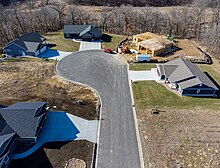
Back طريق مسدود Arabic Atzucac Catalan بنبەست CKB Slepá pozemní komunikace Czech Blind vej Danish Sackgasse German Senelirejo Esperanto Cul-de-sac Spanish Umbtänav Estonian Kale itsu Basque


A dead end, also known as a cul-de-sac (/ˈkʌldəsæk, ˈkʊl-/;[1] French: [kydsak],[2] lit. 'bag bottom'[3]), or a no through road or no exit road, is a street with only one combined inlet and outlet.
The term "dead end" is understood in all varieties of English but may not be the locally most common expression. Official terminology and traffic signs include many different alternatives. Some of these are used only regionally. In the United States and other countries,[which?] cul-de-sac is often not an exact synonym for dead end and refers to a dead-end street with a circular end allowing for easy turning at the end of the road.[1] In Australia and Canada, a street is usually referred to as a court when it has a bulbous end.
Dead ends are added to road layouts in urban planning to limit through-traffic in residential areas. While some dead ends provide no possible passage except in and out of their road entry, others allow cyclists, pedestrians or other non-automotive traffic to pass through connecting easements or paths, an example of filtered permeability. The International Federation of Pedestrians proposed to call such streets "living end streets"[4] and to provide signage at the entry of the streets that make this permeability for pedestrians and cyclists clear. Its application retains the dead end's primary function as a non-through road, but establishes complete pedestrian and bicycle network connectivity.
- ^ a b Company, Houghton Mifflin Harcourt Publishing. "The American Heritage Dictionary entry: cul-de-sac". www.ahdictionary.com.
- ^ https://www.cnrtl.fr/definition/cul-de-sac
- ^ "cul-de-sac". Oxford English Dictionary (Online ed.). Oxford University Press. (Subscription or participating institution membership required.)
- ^ "living end streets". Pedestrians-int.org. Retrieved 2019-08-26.
© MMXXIII Rich X Search. We shall prevail. All rights reserved. Rich X Search